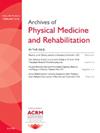Repeatability and Validity of the Prosthetic Observational Gait Scale in Patients with Bilateral Lower Limb Amputations 4345
IF 3.6
2区 医学
Q1 REHABILITATION
Archives of physical medicine and rehabilitation
Pub Date : 2025-04-01
DOI:10.1016/j.apmr.2025.01.029
引用次数: 0
Abstract
Objectives
To investigate the repeatability and validity of the Prosthetic Observational Gait Scale (POGS) in individuals with bilateral lower limb amputations. Establishing its repeatability and validity underscored the significance of POGS in clinical practice, providing a simple yet reliable means of quantitative gait assessment accessible to a broad range of clinicians.
Design
Prospective observational cohort study on the interrater and intrarater validation and repeatability of POGS.
Setting
The study participants were obtained from the Superhumans Center (Vynnyky, Lviv, Ukraine)—a medical center for prosthetics, reconstructive surgery, and the rehabilitation of people affected by the war. Outpatient rehabilitation and follow-up post discharge.
Participants
In the current study were observed 12 male patients (N=12), who had bilateral lower limb amputees due to combat actions: 4 TF bilateral, 4 TT bilateral, 3 hip disarticulation+TF, and 1 TF+TT. The average age of participants was 37±11 years.
Interventions
Six observers, all of whom were physiotherapists, scored the patients’ videos using the observational gait scale. All had access to video playback facilities, enabling pause and slow-motion viewing. These videos were then reassessed in a new, randomly selected order at least 1 week after the initial analysis.
Main Outcome Measures
The study aimed to investigate the consistency of gait assessments made by different observers (interrater) and the same observer over time (intrarater).
Results
The intraobserver (COR) had an average coefficient of 8.7 (range, 6.1-11.7), indicating poor repeatability over time. Observers: 1 COR, 6.9; 2 COR, 7.2; 3 COR, 10.4; 4 COR, 6.1; 5 COR, 9.6; and 6 COR, 11.7. Two-way analysis of variance for the factor “observer,” P=.0009. The overall percentage agreement ranged from 43% to 93%. Kappa statistics for the 26 items, 5 showed good agreement, 11 moderate agreement, 6 fair agreement, and 4 poor agreement.
Conclusions
In summary, the study reveals concerns regarding the scale's (POGS) reliability in individuals with bilateral lower limb amputations. Intraobserver repeatability demonstrated significant variability over time, with each observer showing varying levels of consistency. The interobserver repeatability also raised concerns, indicating poor agreement among different observers. Given these limitations, it is advisable to integrate instrumental video analysis into clinical practice for individuals with bilateral lower limb amputations.
Disclosures
none.
双侧下肢截肢患者假肢观察步态量表的可重复性和有效性[43]
目的探讨双侧下肢截肢患者假肢观察步态量表(POGS)的可重复性和有效性。建立其重复性和有效性强调了POGS在临床实践中的重要性,为广泛的临床医生提供了一种简单而可靠的定量步态评估方法。设计前瞻性观察队列研究,对POGS的判读间和判读内验证和可重复性进行研究。研究参与者来自超人中心(Vynnyky, Lviv, Ukraine),这是一家为受战争影响的人提供假肢、重建手术和康复的医疗中心。门诊康复及出院后随访。本研究观察了12例因战斗而导致双侧下肢截肢的男性患者(N=12): 4例双侧TF, 4例双侧TT, 3例髋关节脱臼+TF, 1例TF+TT。参与者平均年龄37±11岁。干预:六名观察员,他们都是物理治疗师,使用观察步态量表对患者的视频进行评分。所有设备都有视频播放设备,可以暂停和慢动作观看。这些视频然后重新评估在一个新的,随机选择的顺序在最初的分析后至少一周。本研究旨在调查不同观察者(interrater)和同一观察者随时间(intrarater)步态评估的一致性。结果内观察者(COR)的平均系数为8.7(范围为6.1 ~ 11.7),随着时间的推移重复性较差。观察者:1 COR, 6.9;林后2,7.2;林前3:10 4;4芯,6.1;5 cor, 9.6;林前六章11.7节。因子“观察者”的双向方差分析,P=.0009。总体上同意的比例从43%到93%不等。26项的Kappa统计结果显示,符合良好的5项,符合中等的11项,符合一般的6项,不符合较差的4项。结论综上所述,本研究揭示了对双侧下肢截肢患者量表(POGS)可靠性的担忧。观察者内部的重复性随着时间的推移表现出显著的可变性,每个观察者表现出不同程度的一致性。观察员之间的可重复性也引起了关注,表明不同观察员之间的意见不一致。鉴于这些局限性,建议将仪器视频分析纳入双侧下肢截肢患者的临床实践。
本文章由计算机程序翻译,如有差异,请以英文原文为准。
求助全文
约1分钟内获得全文
求助全文
来源期刊
CiteScore
6.20
自引率
4.70%
发文量
495
审稿时长
38 days
期刊介绍:
The Archives of Physical Medicine and Rehabilitation publishes original, peer-reviewed research and clinical reports on important trends and developments in physical medicine and rehabilitation and related fields. This international journal brings researchers and clinicians authoritative information on the therapeutic utilization of physical, behavioral and pharmaceutical agents in providing comprehensive care for individuals with chronic illness and disabilities.
Archives began publication in 1920, publishes monthly, and is the official journal of the American Congress of Rehabilitation Medicine. Its papers are cited more often than any other rehabilitation journal.

 求助内容:
求助内容: 应助结果提醒方式:
应助结果提醒方式:


